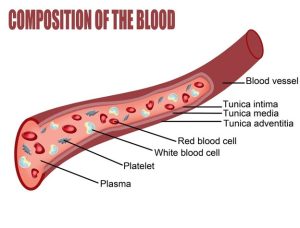January is recognized as National Blood Donor Month, but what makes blood and blood donation so important?
What is blood?
Blood is an essential bodily fluid that constantly flows through your body keeping it working. It has four main components: red blood cells, white blood cells, plasma, and platelets. Each part is designed to specific tasks.
Plasma
The majority of blood—approximately 55%—is composed of plasma. It is yellowish fluid that is a mixture of water, sugar, fats, proteins, and salts. Its main task is to transport blood cells throughout the body, but is also moves products like nutrients, proteins, hormones, and waste.
Red Blood Cells
The second largest component in blood is red blood cells (RBCs), or erythrocytes, making up about 40 – 45 percent of its total volume. These cells contain a protein called hemoglobin, which helps carry oxygen from the lungs to the rest of the body. Hemoglobin also gives RBCs, and the rest of the blood, their distinct red color.
White Blood Cells
White blood cells, or leukocytes, make up a much smaller portion than red blood cells about 1% of the blood. Their role is to protect the body from infections.
Platelets
Unlike red and white blood cells, platelets are not actually cells, but rather fragments of cells. They are the small component within blood being less than 1% of the total volume of blood. Platelets manage bleeding by assisting in the blood clotting process (coagulation) to seal damaged blood vessels to prevent a large amount of blood loss.
What are the blood types?
Blood also contains antigens, and a protein called the Rh factor, which serve as markers that determine a person’s blood type. Based on antigens alone, there are four main blood types: A, B, AB, and O. However, the Rh factor further classifies blood as either positive (+) or negative (-), resulting in a total of eight common blood types: A positive (A+), A negative (A-), B positive (B+), B negative (B-), AB positive (AB+), AB negative (AB-), O positive (O+), and O negative (O-). The most common blood type, in the United States, is O positive (O+); the least common, in the United States, is AB negative (AB-).
| Blood Type | Approximate U.S. Population Percentage |
| A positive | 33% |
| A negative | 6% |
| B positive | 9% |
| B negative | < 2% |
| AB positive | < 4% |
| AB negative | < 1% |
| O positive | 38% |
| O negative | 7% |
Understanding blood types enables healthcare providers to safely perform blood transfusions and organ transplants by ensuring compatibility between the donor and the recipient. Additionally, those with AB positive (AB+) blood are known as universal recipients; those with O negative (O-) blood are universal donors.
What’s the importance of blood donors?
According to the American Red Cross, someone in the United States needs blood and/or platelets every two seconds. That is about 29,000 units of red blood cells, 5,000 units of platelets, and 6,500 units of plasma needed daily. Nonetheless, there is no substitute or manufactured version for blood, which means it has to be generously donated by volunteers. It is important for surgeries, cancer treatment, childbirth, chronic illnesses (e.g., sickle cell disease), and traumatic injuries (e.g., car accidents). For more information on the donation process and how to prepare for a donation check out this website from the U.S. Department of Health and Human Services (HHS).
To the almost 7 million people in the United States who donate their time and blood, thank you. Your single donation has saved multiple lives, and your generosity is worth celebrating.
Sources
American Society of Hematology
- Today’s Risk for Tomorrow: Personal Finance Series (Part 3) - October 24, 2025
- Saving for Tomorrow: Personal Finance Series (Part 2) - September 26, 2025
- Budgeting Basics: Personal Finance Series (Part 1) - September 5, 2025

